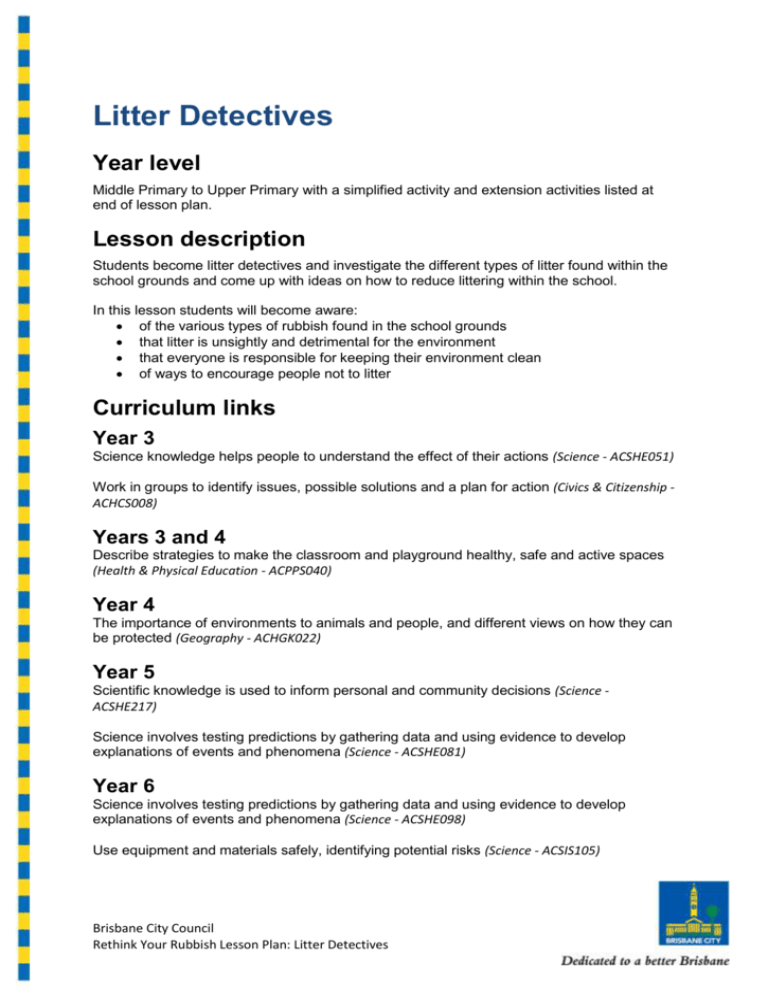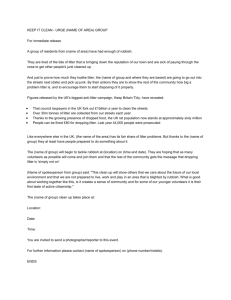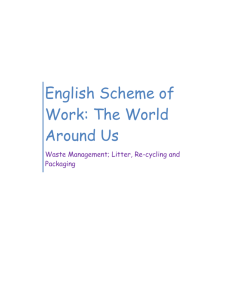Litter detectives (Word - 121kb)
advertisement

Litter Detectives Year level Middle Primary to Upper Primary with a simplified activity and extension activities listed at end of lesson plan. Lesson description Students become litter detectives and investigate the different types of litter found within the school grounds and come up with ideas on how to reduce littering within the school. In this lesson students will become aware: of the various types of rubbish found in the school grounds that litter is unsightly and detrimental for the environment that everyone is responsible for keeping their environment clean of ways to encourage people not to litter Curriculum links Year 3 Science knowledge helps people to understand the effect of their actions (Science - ACSHE051) Work in groups to identify issues, possible solutions and a plan for action (Civics & Citizenship ACHCS008) Years 3 and 4 Describe strategies to make the classroom and playground healthy, safe and active spaces (Health & Physical Education - ACPPS040) Year 4 The importance of environments to animals and people, and different views on how they can be protected (Geography - ACHGK022) Year 5 Scientific knowledge is used to inform personal and community decisions (Science ACSHE217) Science involves testing predictions by gathering data and using evidence to develop explanations of events and phenomena (Science - ACSHE081) Year 6 Science involves testing predictions by gathering data and using evidence to develop explanations of events and phenomena (Science - ACSHE098) Use equipment and materials safely, identifying potential risks (Science - ACSIS105) Brisbane City Council Rethink Your Rubbish Lesson Plan: Litter Detectives Materials Gloves Tongs Bags or buckets for rubbish Map of school Procedure 1. Discuss the problem with litter. Questions might include: What is litter and where does it come from? o Litter is rubbish that comes about when people don’t put their rubbish in the bin properly, or drop rubbish on the ground or leave it where it can be spilled and scattered by wildlife or weather. What are some of the problems with litter? o It looks ugly. Animals often mistake litter for food or can become entangled or snared in it. In Moreton Bay for example a large number of turtles die because they mistake plastic bags for jelly fish. It can also contaminate soil and water, attract vermin like rats or cockroaches and cause injuries, for example, by stepping on broken glass. Unfortunately many litter items also take an incredibly long time to break down and may remain in the environment for hundreds of years . Have any of you ever littered? Why? 2. Explain to students that they are going to be litter detectives and find out what sort of littering occurs at the school. First they will collect litter from the most littered areas within the school and then they will analyse the results. 3. Ask students where they expect to find the most litter in the school and why they think that these spots are the most heavily littered. 4. Divide the class into small groups and using student suggestions as to the most heavily littered sites, allocate an area for each group to search for litter. The sites can be indoors or outdoors and must be as specific as possible, for example, the area including two metres each side of the footpath from the front gate to where it reaches the school buildings . Mark each location on the map showing the boundaries for each site area. 5. Provide each group with rubbish collecting bags, gloves and tongs. 6. Explain that each group will have 15 minutes to collect all the rubbish that they can find within their area and then they are to return to the meeting area to sort their findings. 7. Once students have collected litter have them sort the litter into categories (such as paper, food waste, soft plastics) and share this information on a whiteboard or excel sheet. 8. Have each group discuss their findings with the rest of the class including: What was the most common item that you found? What was the most common material that you found? Brisbane City Council Rethink Your Rubbish Lesson Plan: Litter Detectives Why do you think that there was so much rubbish at this location and how did think it got there? Could any of the rubbish items be reused, recycled or composted? Are you able to tell from the litter which age group may be most responsible for the litter? Where are the closest bins to the litter? 9. Ask students to create a bar graph to visually represent their results. Discuss the design of this graph. For example, should it simply be three columns labelled recyclable waste, general waste and compostable waste, or do they want to break this data down further and have columns for paper, cardboard, plastic containers, foil, soft plastics, glass bottles, cans, non-compostable food waste, compostable waste and miscellaneous general waste. 10. Explain to students that it is not rubbish which is the problem, but people. Littering is almost always the result of poor disposal. Ask students to come up with some suggestions for reducing litter within the school. Use these ideas as the basis for a school anti littering campaign. Extension activities Use the information obtained from the litter audit to form a campaign to fight litter within the school. Students might like to give a presentation at parade on the need to reduce litter. Take photos of the litter count to use in the presentation or display. Create posters and a power point presentation showing why we should pick up our rubbish. Organise a speaker from Take 3, Keep Queensland Beautiful, Brisbane City Council or Healthy Waterways to come and speak to the students about why it is so important to be responsible for our rubbish. Set up two fishbowls or aquariums. In one, add lots of rubbish and in the other add live fish and plants. Place the aquariums side by side so that students can see the difference and do not clean the aquarium with the rubbish. Simplified activity As a class carry out a litter audit in an area close to the classroom and make a display using all the litter collected. Discuss ways to reduce litter within the school. Brisbane City Council Rethink Your Rubbish Lesson Plan: Litter Detectives





